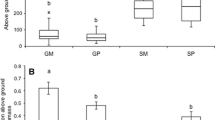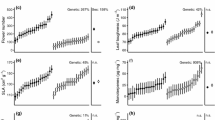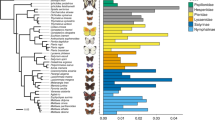Abstract
There has been a renewed interest in the effects of genetic diversity on population-level and community-level processes. Many of these studies have found non-additive, positive effects of diversity, but these studies have rarely examined ecological mechanisms by which diverse populations increase productivity. We used the seed beetle Callosobruchus maculatus (Coleoptera: Chrysomelidae) to study genetic diversity in insect host preference and fecundity and its effects on total productivity and resource use. We created genetically distinct lineages that varied in host preference and fecundity and then assembled groups consisting of one, three, five, or all ten lineages. We found that lineages with intermediate diversity had the highest productivity, though resource use did not change in diverse groups. In addition, lineages showed substantial plasticity in host preference when preference was assayed either individually or in groups, and productivity was much lower in groups than predicted by individual assays. These results highlight the interplay of genetic diversity, resource variation, and phenotypic plasticity in determining the ecological consequences of genetic diversity. In addition, when plasticity modifies a population’s response to population density, this may create a complex interaction between genetic diversity and density, influencing selective pressures on the population and potentially maintaining genetic diversity across generations.






Similar content being viewed by others
References
Agashe D (2009) The stabilizing effect of intraspecific genetic diversity on population dynamics in novel and ancestral habitats. Am Nat 174:255–267
Agashe D, Bolnick DI (2010) Intraspecific genetic variation and competition interact to influence niche expansion. Proc Royal Soc: Biol Sci 277:2915–2924
Agrawal AA (2001) Phenotypic plasticity in the interactions and evolution of species. Science 294:321–326
Aguirre JD, Marshall DJ (2012) Genetic diversity increases population productivity in a sessile marine environment. Ecology 93:1134–1142
Bassar RD, López-Sepulcre A, Walsh MR, Turcotte MM, Torres-Mejia M, Reznick DR (2010) Briding the gap between ecology and evolution: integrating density regulation and life-history evolution. Ann N Y Acad Sci 1206:17–34
Bates D, Maechler M, Bolker B (2011) lme4: Liner mixed-effects models using S4 classes. R package version 0.999375-42. http://CRAN.R-project.org/package=lme4
Benard MF, Maher JM (2011) Consequences of intraspecific niche variation: phenotypic similarity increases competition among recently metamorphosed frogs. Oecologia 166:585–592
Bolnick DI, Svanbäck R, Fordyce JA, Yang LH, Davis JM, Hulsey CD, Forister ML (2003) The ecology of individuals: incidence and implications of individual specialization. Am Nat 161:1–28
Carroll SP, Hendry AP, Reznick DN, Fox CW (2007) Evolution on ecological time-scales. Funct Ecol 21:387–393
Cook-Patton SC, McArt SH, Parachnowitsch AL, Thaler JS, Agrawal AA (2011) A direct comparison of the consequences of plant genotypic and species diversity on communities and ecosystem function. Ecology 92:915–923
Crawford KM, Crutsinger GM, Sanders NJ (2007) Host-plant genotypic diversity mediates the distribution of an ecosystem engineer. Ecology 88:2114–2120
Crutsinger GM, Collins MD, Fordyce JA, Gompert Z, Nice CC, Sanders NJ (2006) Plant genotypic diversity predicts community structure and governs an ecosystem process. Science 313:966–968
Crutsinger GM, Strauss SY, Rudgers JA (2010) Genetic variation within a dominant shrub species determines plant species colonization in a coastal dune ecosystem. Ecology 91:1237–1243
Davis JM, Nufio CR, Papaj DR (2011) Resource quality or competition: why increase resource acceptance in the presence of conspecifics? Behav Ecol 22:730–737
de Witt TJ, Sih A, Wilson DS (1998) Costs and limits of phenotypic plasticity. Trends Ecol Evol 13:77–81
Donohue K, Polisetty CR, Wender NJ (2005) Genetic basis and consequences of niche construction: plasticity-induced genetic constraints on the evolution of seed dispersal in Arabidopsis thaliana. Am Nat 165:537–550
Fisher RA (1937) The wave of advance of advantageous genes. Ann Eugenics 7:353–369
Ford EB (1964) Ecological genetics. Chapman and Hall, London
Fordyce JA, Gompert Z, Forister ML, Nice CC (2011) A hierarchical Bayesian approach to ecological count data: a flexible tool for ecologists. PLoS One 6:e26785
Forister MF, Scholl CF (2012) Use of an exotic host plant affects mate choice in an insect herbivore. Am Nat 179. doi:10.1086/665648
Forister MF, Ehmer AG, Futuyma DJ (2007) The genetic architecture of a niche: variation and covariation in host use traits in the Colorado potato beetle. J Evol Biol 20:985–996
Forister MF, Gompert Z, Nice CC, Forister GW, Fordyce JA (2011) Ant association facilitates the evolution of diet breadth in a lycaenid butterfly. Proc Royal Soc B 278:1539–1547
Forister MF, Scholl CF, Jahner JP, Wilson JS, Fordyce JA, Gompert Z, Narala D, Buerkle CA, Nice CC (2012a) Specificity, rank preference and the colonization of a non-native host plant by the Melissa blue butterfly. Oecologia. doi:10.1007/s00442-012-2476-8
Forister ML, Dyer LA, Singer MS, Stireman JO III, Lill JT (2012b) Revisiting the evolution of ecological specialization, with emphasis on animal-plant interactions. Ecology 93:981–991
Forsman A, Ahnesjö J, Ceasar S, Karlsson M (2008) A model of ecological and evolutionary consequences of color polymorphism. Ecology 89:34–40
Forsman A, Wennersten L, Karlsson M, Caesar S (2012) Variation in founder groups promotes establishment success in the wild. Proc Royal Soc: Biol Sci 279:2800–2806
Fox CW (1993) A quantitative genetic analysis of oviposition preference and larval performance on two hosts in the bruchid beetle, Callosobruchus maculatus. Evolution 47:166–175
Fox CW, Reed DH (2011) Inbreeding depression increases with environmental stress: an experimental study and meta-analysis. Evolution 65:246–258
Fox CW, Thaker MS, Mousseau TA (1997) Egg size plasticity in a seed beetle: an adaptive maternal effect. Am Nat 149:149–163
Fox CW, Sheibly KL, Smith BP, Wallin WG (2007) Inbreeding depression in seed-feeding beetles, Callosobruchus maculatus and Stator limbus (Coleoptera: chrysomelidae). Bull Entomol Res 97:49–54
Fridley JD, Grime JP (2010) Community and ecosystem effects of intraspecific genetic diversity in grassland microcosms of varying species diversity. Ecology 91:2272–2283
Futuyma DJ, Peterson SC (1985) Genetic variation in the use of resources by insects. Annu Rev Entomol 30:217–238
Gompert Z, Fordyce JA (2011) bayespref: Hierarchical Bayesian analysis of ecological count data. R package version 1.0. http://CRAN-Rproject.org/package=bayespref
Hairston NG Jr, Ellner SP, Geber MA, Yoshida T, Fox JA (2005) Rapid evolution and the convergence of ecological and evolutionary time. Ecol Lett 8:1114–1127
Hanski IA (2011) Eco-evolutionary spatial dynamics in the Glanville fritillary butterfly. Proc Natl Acad Sci 108:14397–14404
Hanski IA, Singer MC (2001) Extinction-colonization dynamics and host-plant choice in butterfly metapopulations. Am Nat 158:341–353
Hothorn T, Bretz F, Westfall P (2008) Simultaneous inference in general parametric models. Biom J 50:346–363
Hughes AR, Inouye BD, Johnson MTJ, Underwood N, Vellend M (2008) Ecological consequences of genetic diversity. Ecol Lett 11:609–623
Huston MA (1997) Hidden treatments in ecological experiments: re-evaluating the ecosystem function of biodiversity. Oecologia 110:449–460
Jaenike J (1990) Host specialization in phytophagous insects. Annu Rev Ecol Syst 21:243–273
Jousset A, Schmid B, Scheu S, Eisenhauer N (2011) Genotypic richness and dissimilarity opposingly affect ecosystem functioning. Ecol Lett 14:537–545
Kotowska AM, Cahill JF Jr, Keddie BA (2010) Plant genetic diversity yields increased plant productivity and herbivore performance. J Ecol 98:237–245
Krasnov BR, Khokhlova IS, Shenbrot GI (2003) Density-dependent host selection in ectoparasites: An application of isodar theory to fleas parasitizing rodents. Oecologia 134:365–372
Kristensen TN, Barker JSF, Pederson KS, Loeschcke V (2008) Extreme temperatures increase the deleterious consequences of inbreeding under laboratory and semi-natural conditions. Proc Royal Soc B: Biol Sci 275:2055–2061
Lind MI, Johansson F (2009) Costs and limits of phenotypic plasticity in island populations of the common frog Rana temporaria under divergent selection pressures. Evolution 63:1508–1518
McCann KS (2000) The diversity-stability debate. Nature 405:228–233
Messina FJ (1990) Alternative life-histories in Callosobruchus maculatus: Environmental and genetic bases. In: Fujii K, Gatehouse AMR, Johnson CD, Mitchell R, Yoshida T (eds) Bruchids and legumes: economics, ecology, and coevolution. Kluwer Academic Publishers, The Netherlands
Messina FJ (1991) Life-history variation in a seed beetle: adult egg-laying vs. larval competitive ability. Oecologia 85:447–455
Messina FJ (2004) How labile are the egg-laying preferences of seed beetles? Ecol Entomol 29:318–326
Messina FJ, Karren ME (2003) Adaptation to a novel host modifies hsot discrimination by the seed beetle Callosobruchus maculatus. Anim Behav 65:501–507
Messina FJ, Slade AF (1997) Inheritance of host-plant choice in the seed beetle Callosobruchus maculatus (Coleoptera: Bruchidae). Ann Entomol Soc Am 90:848–855
Messina FJ, Jones JC, Mendenhall M, Muller A (2009) Genetic modification of host acceptance by a seed beetle, Callosobruchus maculatus (Coleoptera: Bruchidae). Ann Entomol Soc Am 102:181–188
Noguchi K, Hui WLW, Gel YR, Gastwirth JL, Miao W (2009) lawstat: an R package for biostatistics, public policy, and law. R package version 2.3. http://CRAN.R-project.org/package=lawstat
Nylin S, Janz N (2009) Butterfly host plant range: an example of plasticity as a promoter of speciation? Evol Ecol 23:137–146
Pienaar J, Greeff JM (2003) Maternal control of offspring sex and male morphology in the Otitesella fig wasp. J Evol Biol 16:244–253
Price TD, Qvarnström A, Irwin DE (2003) The role of phenotypic plasticity in driving genetic evolution. Proc Royal Soc: Biol Sci 270:1433–1440
R Development Core Team (2012) R: a language and environment for statistical computing. R. Foundation for Statistical Computing, Vienna, Austria. ISBN3-900051-07-0. http://www.R-project.org/
Relyea RA (2002) Costs of phenotypic plasticity. Am Nat 159:272–282
Roff DA (2007) A centennial celebration for quantitative genetics. Evolution 61:1017–1032
Schoener TW (2011) The newest synthesis: understanding the interplay of evolutionary and ecological dynamics. Science 331:426–429
Tack AJM, Roslin T (2011) The relative importance of host-plant genetic diversity in structuring the associated herbivore community. Ecology 92:1594–1604
Teixeira IR, Barchuk AR, Medeiros L, Zucoloto FS (2009) Females of the weevil Zabrotes subfasciatus manipulate the size and number of eggs according to the host seed availability. Physiol Entomol 34:246–250
Thompson JN (1988) Evolutionary ecology of the relationship between oviposition preference and performance of offspring in phytophagous insects. Entomol Exp Appl 47:3–14
Tilman D (2004) Niche tradeoffs, neutrality, and community structure: a stochastic theory of resource competition, invasion, and community assembly. Proc Natl Acad Sci 101:10854–10861
Tilman D, Downing JA (1994) Biodiversity and stability in grasslands. Nature 367:363–365
Van Valen L (1965) Morphological variation and width of ecological niche. Am Nat 99:377–390
Wacker L, Baudois O, Eichenberger-Glinz S, Schmid B (2008) Environmental heterogeneity increases complementarity in experimental grassland communities. Basic Appl Ecol 9:467–474
Wallin KF, Raffa KF (2004) Feedback between individual host selection behavior and population dynamics in an eruptive herbivore. Ecol Monogr 74:101–116
Weltzin JF, Muth NZ, Von Holle B, Cole PG (2003) Genetic diversity and invasibility: a test using a model system with a novel experimental design. Oikos 103:505–518
Wender NJ, Polisetty CR, Donohue K (2005) Density-dependent processes influencing the evolutionary dynamics of dispersal: a functional analysis of seed dispersal in Arabidopsis thaliana (Brassicaceae). Am J Bot 92:960–971
Wennersten L, Forsman A (2012) Population-level consequences for polymorphism, plasticity, and randomized phenotype switching: a review of predictions. Biol Rev 87:756–767
Wilson MR, Leather SR (2012) The effect of past natural enemy activity on host-plant preference of two aphid species. Entomologia Experimentalis et Applicata 144:216–222
Wilkinson A, Solan M, Taylor AFS, Alexander IJ, Johnson D (2010) Intraspecific diversity regulates fungal productivity and respiration. PLoS One 5:e12604
Wise CA, Ranker TA, Linhart YB (2002) Modeling problems in conservation genetics with Brassica rapa: genetic variation and fitness in plants under mild, stable conditions. Conserv Biol 16:1542–1554
Acknowledgments
We would like to thank Charles Fox for sending us the C. maculatus populations used in this study. We would also like to thank J. Jahner and two anonymous reviewers for their thoughtful reviews of an earlier version of this manuscript.
Author information
Authors and Affiliations
Corresponding author
Additional information
Communicated by George Heimpel.
Rights and permissions
About this article
Cite this article
Burls, K.J., Shapiro, J., Forister, M.L. et al. A nonlinear relationship between genetic diversity and productivity in a polyphagous seed beetle. Oecologia 175, 151–161 (2014). https://doi.org/10.1007/s00442-014-2893-y
Received:
Accepted:
Published:
Issue Date:
DOI: https://doi.org/10.1007/s00442-014-2893-y




